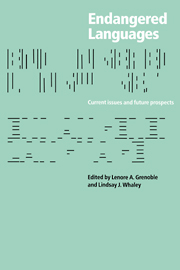Book contents
- Frontmatter
- Contents
- Preface
- List of abbreviations and symbols
- Part I General issues
- Part II Language-community responses
- 3 Technical, emotional, and ideological issues in reversing language shift: examples from Southeast Alaska
- 4 Mayan efforts toward language preservation
- 5 A chronology of Mohawk language instruction at Kahnawà:ke
- 6 Language endangerment in South America: a programmatic approach
- Part III What is lost: language diversity
- Part IV Mechanisms of language loss
- Appendix
- References
- Index of languages
- Index of names
- General index
5 - A chronology of Mohawk language instruction at Kahnawà:ke
Published online by Cambridge University Press: 05 June 2012
- Frontmatter
- Contents
- Preface
- List of abbreviations and symbols
- Part I General issues
- Part II Language-community responses
- 3 Technical, emotional, and ideological issues in reversing language shift: examples from Southeast Alaska
- 4 Mayan efforts toward language preservation
- 5 A chronology of Mohawk language instruction at Kahnawà:ke
- 6 Language endangerment in South America: a programmatic approach
- Part III What is lost: language diversity
- Part IV Mechanisms of language loss
- Appendix
- References
- Index of languages
- Index of names
- General index
Summary
The following is a chronology of developments since the inception of the Kanien'kéha (Mohawk) language instruction program into our school system in Kahnawà:ke, Quebec, the mistakes we made, and also the status of the program today.
The development of the Kanien'kéha program
Prior to 1970, the only thing native in our schools was the children. There were no native teachers, no native content, no relevant history, no stories, no songs, no pictures, and least of all, there was no Mohawk language. This had a very negative impact on our self-identity and our self-image, so one of the goals of our program today is to reverse this by immersing children not only in Mohawk language, but also by surrounding them with native teachers, content, history, culture, pictures, and stories.
In September, 1970, due to the efforts of a small group of parents and a sympathetic non-native principal, the Mohawk language was introduced into our schools for fifteen minutes every day for every grade. Three courageous people from the community were asked to take on this challenge and teach. They applied for and received a small grant from the Federal Department of Cultural Affairs to cover a small salary. These people had no training and no materials, but what they did have was the conviction that this was something that had to be done. They also planted a seed: the daily instruction increased from fifteen minutes a day to a half hour over the next several years.
- Type
- Chapter
- Information
- Endangered LanguagesLanguage Loss and Community Response, pp. 117 - 123Publisher: Cambridge University PressPrint publication year: 1998
- 8
- Cited by



